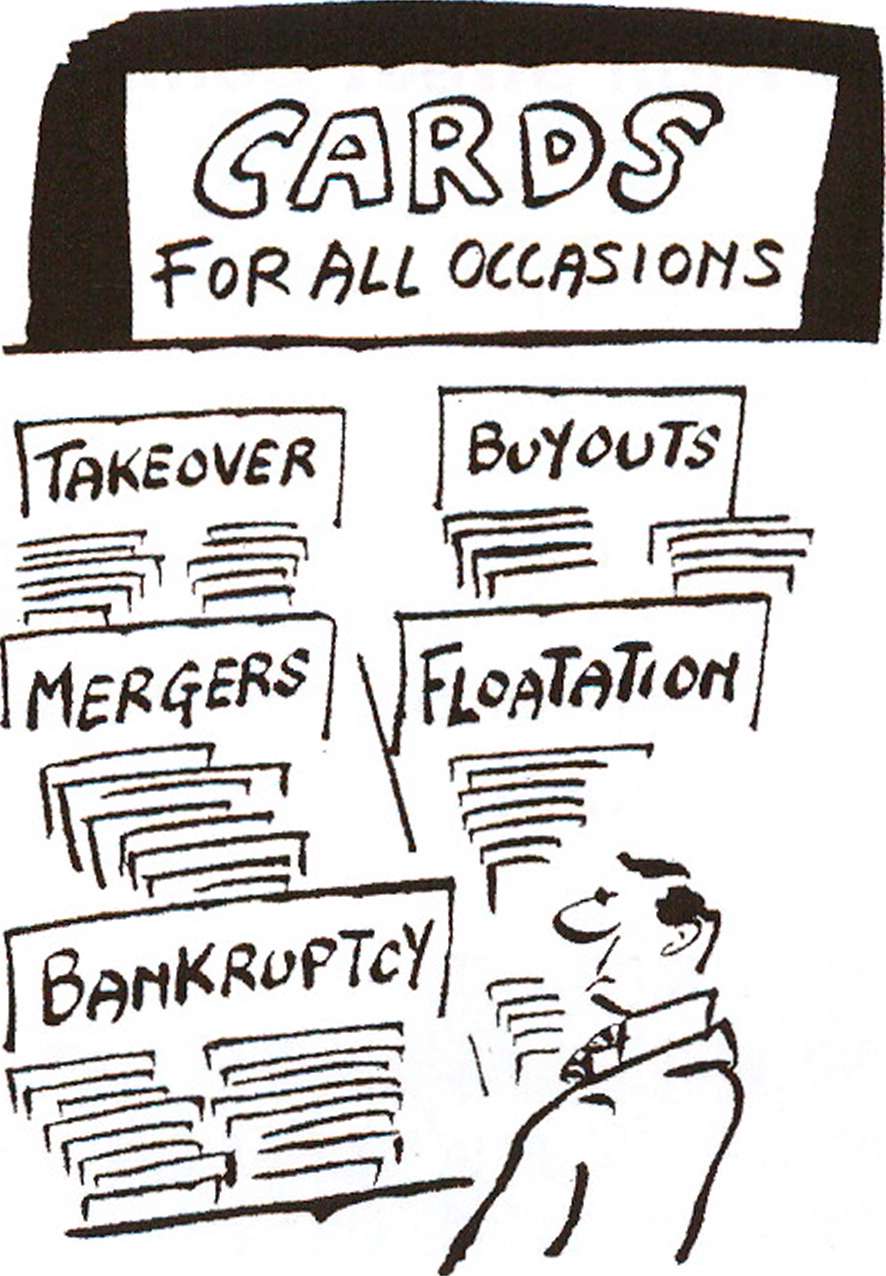
CATEGORIES:
BiologyChemistryConstructionCultureEcologyEconomyElectronicsFinanceGeographyHistoryInformaticsLawMathematicsMechanicsMedicineOtherPedagogyPhilosophyPhysicsPolicyPsychologySociologySportTourism
Leveraged buyouts
Conglomerates
A series of takeovers can result in a parent company controlling a number of subsidiaries: smaller companies that it owns. When the subsidiaries operate in many different business areas, the company is known as a conglomerate.
But large conglomerates can become inefficient. Top executives often leave after hostile takeovers, and too much diversification means the company is no longer concentrating on its core business: its central and most important activity. Takeovers do not always result in synergy: combined production or productivity that is greater than the sum of the separate parts. In fact, statistics show that most mergers and acquisitions reduce rather than increase a company's value.
An inefficient conglomerate whose profits are too low can have a low stock price, and its market capitalization - the total market price of all its ordinary shares - can fall below the value of its assets, including land, buildings and pension funds. If this happens, it becomes profitable for another company to buy the conglomerate and either split it up and sell it as individual companies, or close the companies and sell the assets. This practice, common in the USA but rare in Europe or Asia, is called asset-stripping. It shows that stock markets are not always efficient (see Unit 30), and that companies can sometimes be undervalued or underpriced: the price of their shares on the stock market can be too low. Some people argue that asset-stripping is a good way of using capital more efficiently; others argue that it is an unfortunate activity that destroys companies and jobs.
Raiders
If corporate raiders - individuals or companies that want to take over other companies - borrow money to do so, usually by issuing bonds, the takeover is called a leveraged buyout or LBO. Leveraged means largely financed by borrowed capital. After the takeover, the raider sells subsidiaries of the company in order to pay back the bondholders.
Bonds issued to pay for takeovers are usually called junk bonds because they are risky: it may not be possible to sell the subsidiaries at a profit. But, because of the risk, these bonds pay a high interest rate, so some investors are happy to buy them.



Sometimes a company's own managers want to buy the company, and re-organize it. This is a management buyout or MBO. If the buyout is financed by issuing preference shares and convertibles, this is callcd mezzanine financing as it is, in a sense, halfway between debt and equity. (See Unit 28 for another use of 'mezzanine financing'.)
40.1 Match the words in the box with the definitions below. Look at A and B opposite to help you.
| asset-stripping | core business | leveraged | market capitalization |
| parent company | subsidiaries | synergy |
1 a company that owns or controls one or more other companies
2 the main activity of a company
3 buying a company in order to sell some of its assets
4 companies partly or wholly owned by another company
5 having a lot of borrowed money compared to one's own funds
6 the total value of a company on the stock exchange •
7 two things working together that produce an effect greater than the sum of their individual effects
40.2 Match the two parts of the sentences. Look at A and B opposite to help you.
1 Large conglomerates formed by takeovers
2 If a conglomerate diversifies and doesn't concentrate on its core business,
3 An inefficient conglomerate's stock market value
4 If a company is worth less than its assets,
5 Raiders do not need to have very much money of their own if
a can be less than the sale value of all its assets, b can become inefficient, especially if they are very diversified, c they use leverage, and issue junk bonds, d there might not be synergies among all its different activities, e you can make a profit by buying it and selling the parts.
40.3 Put the sequence of events in the correct order. The first stage is a. Look at B opposite to help you.
a Corporate raiders calculate that a large company is undervalued, b Investors buy the bonds because they pay a high interest rate, c The new owners sell some of the company's subsidiaries, d The new owners repay the bondholders, e The raiders buy the company.
f The raiders issue bonds to raise capital to buy the company.
| 1 (K 2 | 3 4 5 6 |
| ______________________ ifefc | |
| Ove,r +o upu What are the most div you think this is? | |
| ersified conglomerates you know of? Are they successful? Why do — - . _ . _ _ — u |
Date: 2015-02-28; view: 5180
| <== previous page | | | next page ==> |
| Mergers and takeovers | | | Financial planning |